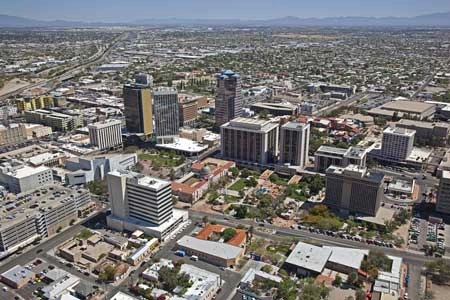Public Policy Review

Arizona’s continued rapid growth raises concerns about the connection between growth and water supplies. The issue is on the minds of many; I am frequently asked about the sufficiency of supplies relative to growing demands. After Tucson Water presented its draft long-range plan, Tucson Water Plan 2000-2050, representatives of community business groups asked me to help them interpret the plan and the broad regional water supply picture. Along with explaining aspects of the plan, I also was asked to numerically calculate the number of people able to be supported by known available water supplies in the Tucson region.
Writing a report explaining the context for long-range water planning was an appealing task, although I was at first uncomfortable about the numerical calculation. My concern was that the focus would be on the numbers rather than the context. Nevertheless, I saw the value of providing alternative illustrative scenarios. I agreed to produce the report.
Since the release of Water Resource Availability for the Tucson Metropolitan Region this summer, I have presented its findings numerous times. The report appears to have encouraged an understanding of the many factors that help answer questions about the sufficiency of water supplies — and how assumptions regarding these factors affect the conclusions.
What were the report’s findings and conclusions? As the Tucson region strives to achieve the statutory management goal of safe-yield, multiple sources of water are available. We are not yet utilizing all of the region’s allocated Central Arizona Project water. We use only a small portion of the effluent from the regional treatment plants. More opportunities are available to conserve water. Relying on reasonable assumptions and publicly available information, I concluded that water supplies are more than adequate for the population that the Pima Association of Governments projects will live in the region in 2030: about 1.5 million people. A caveat, however, is that the community needs to make decisions necessary to utilize these supplies, and some water use options could be controversial.
A key factor determining the adequacy of supplies is the rate at which the community utilizes effluent. Effluent will likely be used in the future for more than golf courses and other turf irrigation. Will it be used through recharge and recovery? Will the recovery occur inside or outside the area of hydrologic impact of the recharge? Will effluent be treated using sophisticated and currently costly membrane treatment technology? And a very controversial question: Will the public accept the mixing of treated effluent with potable water? The community has not yet begun discussing these questions as its attention is more focused on the challenge of figuring out the best way to utilize the region’s CAP water. But these discussions are on the horizon.
Another important factor is the overall water use of the region, on a per capita basis. Will the mix of commercial activity and the efficiency associated with low-water-using appliances result in a reduction in water use on a per capita basis? Some reduction would be expected, if only because new construction must install low-water use plumbing fixtures. But how much of a reduction? The Tucson Water Plan assumes a gallons-per-capita-per-day (GPCD) total consumption rate of 177 throughout the 50-year planning period. Including all water use in Tucson Water’s service area on a per capita basis, this figure was the utility’s rate when the plan was formulated in late 2004.
The breakdown of the 177 GPCD is as follows: Residential (indoor + outdoor), 110; Reclaimed water, 4; Commercial and Industrial, 35; and lost and unaccounted for water, 18. I used a GPCD figure of 165 in my report’s baseline projections for 2030 and then performed some sensitivity analysis. If consumption were to remain close to the current amount, with population growing 10 percent higher than projected by Pima Association of Governments, water supplies are not expected to stretch much beyond 2030. Remember, however, no projection for 2030 is going to be correct — it all depends on the assumptions!
Although explaining the regulatory context for water planning, the report did not focus on our region’s statutory management goal defined as “safe-yield.” Many factors will determine whether the region meets the safe-yield goal, especially groundwater use by the agricultural and industrial water use sectors. Since these sectors operate under a different set of regulations, they could continue to use groundwater for some time. Any reduced water use they achieve does not result in increased water resources for the municipal sector. However, with only 20 years to go to reach the 2025 safe-yield target date, it is more important than ever to keep sight of this goal. And the study did not address the water needs of the environment, a water-using “sector” not recognized by the Groundwater Management Act.
The report’s findings are consistent with what water managers in the Tucson region have said for some time: enough water resources are available to support a substantial increase in the region’s population. Although the report focuses on Tucson, the methodology applies to any area. The same is true for several of the report’s recommendations regarding community engagement in water management planning deliberations. Water management is not just the concern of water managers. This is becoming increasingly evident as we continue to grow statewide and attempt to identify the source of the next bucket of water to meet our ever-growing demand for water
Water Resource Availability for the Tucson Metropolitan Area is available at the Water Resources Research Center’s web site: www.cals.arizona.edu/azwater

